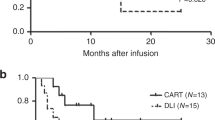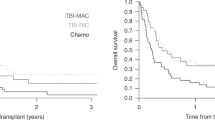Summary:
Donor leukocyte infusion (DLI) alone has very limited efficacy for patients with acute lymphoblastic leukemia (ALL) who have relapsed after allogeneic bone marrow transplantation (BMT). We, therefore, prospectively tested the efficacy of cytoreductive chemotherapy (intermediate-dose cytarabine+idarubicin+etoposide) followed immediately by G-CSF-primed DLI (Chemo-DLI) in 10 relapsed ALL patients after allogeneic BMT. Seven achieved complete remission (CR) at a median of 25 days (19–73 days) after DLI. Of these seven CR patients, only one remains alive in CR 907 days after DLI. Two CR patients died in CR of graft-versus-host disease. The remaining four CR patients relapsed at a median of 153 days (120–991 days) after DLI. One is alive with leukemia at post-DLI day 1217. The median survival duration after DLI was 175 days (15–1217 days). In summary, although Chemo-DLI for relapsed ALL after allogeneic BMT induced a relatively high CR rate, durable remissions were rare. Although our data should be interpreted cautiously considering the small number of patients, these results suggest that poor outcome of DLI in relapsed ALL may be primarily due to intrinsic resistance to graft-versus-leukemia effect rather than to the rapid pace of the disease.
This is a preview of subscription content, access via your institution
Access options
Subscribe to this journal
Receive 12 print issues and online access
$259.00 per year
only $21.58 per issue
Buy this article
- Purchase on SpringerLink
- Instant access to full article PDF
Prices may be subject to local taxes which are calculated during checkout

Similar content being viewed by others
References
Mortimer J, Blinder MA, Schulman S et al. Relapse of acute leukemia after marrow transplantation: natural history and results of subsequent therapy. J Clin Oncol 1989; 7: 50–57.
Frassoni F, Barrett AJ, Granena A et al. Relapse after allogeneic bone marrow transplantation for acute leukaemia: a survey by the EBMT of 117 cases. Br J Haematol 1988; 70: 317–320.
Bostrom B, Woods WG, Nesbit ME et al. Successful reinduction of patients with acute lymphoblastic leukemia who relapse following bone marrow transplantation. J Clin Oncol 1987; 5: 376–381.
Barrett AJ, Joshi R, Tew C . How should acute lymphoblastic leukaemia relapsing after bone-marrow transplantation be treated? Lancet 1985; 1: 1188–1191.
Barrett AJ, Locatelli F, Treleaven JG et al. Second transplants for leukaemic relapse after bone marrow transplantation: high early mortality but favourable effect of chronic GVHD on continued remission. A report by the EBMT Leukaemia Working Party. Br J Haematol 1991; 79: 567–574.
Radich JP, Sanders JE, Buckner CD et al. Second allogeneic marrow transplantation for patients with recurrent leukemia after initial transplant with total-body irradiation-containing regimens. J Clin Oncol 1993; 11: 304–313.
Bosi A, Laszlo D, Labopin M et al. Acute Leukemia Working Party of the European Blood and Marrow Transplant Group. Second allogeneic bone marrow transplantation in acute leukemia: results of a survey by the European Cooperative Group for Blood and Marrow Transplantation. J Clin Oncol 2001; 19: 3675–3684.
Mehta J, Powles R, Treleaven J et al. Outcome of acute leukemia relapsing after bone marrow transplantation: utility of second transplants and adoptive immunotherapy. Bone Marrow Transplant 1997; 19: 709–719.
Kolb HJ, Schattenberg A, Goldman JM et al. Graft-versus-leukemia effect of donor lymphocyte transfusions in marrow grafted patients. European Group for Blood and Marrow Transplantation Working Party Chronic Leukemia. Blood 1995; 86: 2041–2050.
Collins Jr RH, Shpilberg O, Drobyski WR et al. Donor leukocyte infusions in 140 patients with relapsed malignancy after allogeneic bone marrow transplantation. J Clin Oncol 1997; 15: 433–444.
Ferster A, Bujan W, Mouraux T et al. Complete remission following donor leukocyte infusion in ALL relapsing after haploidentical bone marrow transplantation. Bone Marrow Transplant 1994; 14: 331–332.
Kawakami T, Umehara S, Fukunaga M et al. Grade IV graft-versus-host disease and a 1-year remission following donor leukocyte transfusion for treatment of relapsed acute lymphoblastic leukemia. Bone Marrow Transplant 1996; 17: 464–465.
Slavin S, Naparstek E, Nagler A et al. Allogeneic cell therapy with donor peripheral blood cells and recombinant human interleukin-2 to treat leukemia relapse after allogeneic bone marrow transplantation. Blood 1996; 87: 2195–2204.
Russell LA, Jacobsen N, Heilmann C et al. Treatment of relapse after allogeneic BMT with donor leukocyte infusions in 16 patients. Bone Marrow Transplant 1996; 18: 411–414.
Saw MH, Teh A, Wong HC et al. Haematological remission induced by donor leukocytes infusion in a case of Philadelphia positive acute lymphoblastic leukaemia relapsing after allogeneic bone marrow transplantation. Int J Hematol 1997; 65: 173–178.
Atra A, Millar B, Shepherd V et al. Donor lymphocyte infusion for childhood acute lymphoblastic leukaemia relapsing after bone marrow transplantation. Br J Haematol 1997; 97: 165–168.
Keil F, Kalhs P, Haas OA et al. Relapse of Philadelphia chromosome positive acute lymphoblastic leukaemia after marrow transplantation: sustained molecular remission after early and dose-escalating infusion of donor leucocytes. Br J Haematol 1997; 97: 161–164.
Lawson SE, Darbyshire PJ . Use of donor lymphocytes in extramedullary relapse of childhood acute lymphoblastic leukaemia following bone marrow transplantation. Bone Marrow Transplant 1998; 22: 829–830.
Berthou C, Leglise MC, Herry A et al. Extramedullary relapse after favorable molecular response to donor leukocyte infusions for recurring acute leukemia. Leukemia 1998; 12: 1676–1681.
Kolb HJ . Donor leukocyte transfusions for treatment of leukemic relapse after bone marrow transplantation. EBMT Immunology and Chronic Leukemia Working Parties. Vox Sang 1998; 74 (Suppl 2): 321–329.
Collins Jr RH, Goldstein S, Giralt S et al. Donor leukocyte infusions in acute lymphocytic leukemia. Bone Marrow Transplant 2000; 26: 511–516.
Shiobara S, Nakao S, Ueda M et al. Donor leukocyte infusion for Japanese patients with relapsed leukemia after allogeneic bone marrow transplantation: lower incidence of acute graft-versus-host disease and improved outcome. Bone Marrow Transplant 2000; 26: 769–774.
Brouwer RE, van der Heiden P, Schreuder GM et al. Loss or downregulation of HLA class I expression at the allelic level in acute leukemia is infrequent but functionally relevant, and can be restored by interferon. Hum Immunol 2002; 63: 200–210.
Ossendorp F, Eggers M, Neisig A et al. A single residue exchange within a viral CTL epitope alters proteasome-mediated degradation resulting in lack of antigen presentation. Immunity 1996; 5: 115–124.
Hirano N, Takahashi T, Takahashi T et al. Expression of costimulatory molecules in human leukemias. Leukemia 1996; 10: 1168–1176.
Cardoso AA, Schultze JL, Boussiotis VA et al. Pre-B acute lymphoblastic leukemia cells may induce T-cell anergy to alloantigen. Blood 1996; 88: 41–48.
Bergmann L, Schui DK, Brieger J et al. The inhibition of lymphokine-activated killer cells in acute myeloblastic leukemia is mediated by transforming growth factor-beta 1. Exp Hematol 1995; 23: 1574–1580.
Buzyn A, Petit F, Ostankovitch M et al. Membrane-bound Fas (Apo-1/CD95) ligand on leukemic cells: a mechanism of tumor immune escape in leukemia patients. Blood 1999; 94: 3135–3140.
Drobyski WR, Keever CA, Roth MS et al. Salvage immunotherapy using donor leukocyte infusions as treatment for relapsed chronic myelogenous leukemia after allogeneic bone marrow transplantation: efficacy and toxicity of a defined T-cell dose. Blood 1993; 82: 2310–2318.
Dazzi F, Szydlo RM, Craddock C et al. Comparison of single-dose and escalating-dose regimens of donor lymphocyte infusion for relapse after allografting for chronic myeloid leukemia. Blood 2000; 95: 67–71.
Lee JH, Lee KH, Kim S et al. Combination chemotherapy of intermediate-dose cytarabine, idarubicin, plus etoposide and subsequent mobilized donor leukocyte infusion for relapsed acute leukemia after allogeneic bone marrow transplantation. Leuk Res 2001; 25: 305–312.
Lee KH, Lee JH, Choi SJ et al. Randomized comparison of two different schedules of granulocyte colony-stimulating factor administration after allogeneic bone marrow transplantation. Bone Marrow Transplant 1999; 24: 591–599.
Przepiorka D, Weisdorf D, Martin P et al. 1994 consensus conference on acute GVHD grading. Bone Marrow Transplant 1995; 15: 825–828.
Shulman HM, Sullivan KM, Weiden PL et al. Chronic graft-versus-host syndrome in man. A long-term clinicopathologic study of 20 Seattle patients. Am J Med 1980; 69: 204–217.
Choi SJ, Lee KH, Lee JH et al. Prognostic value of hematopoietic chimerism in patients with acute leukemia after allogeneic bone marrow transplantation: a prospective study. Bone Marrow Transplant 2000; 26: 327–332.
Lee KH, Lee JH, Choi SJ et al. Monthly prospective analysis of hematopoietic chimerism after allogeneic hematopoietic cell transplantation. Bone Marrow Transplant 2003; 32: 423–431.
Choi SJ, Lee JH, Lee JH et al. Treatment of relapsed acute myeloid leukemia after allogeneic bone marrow transplantation with chemotherapy followed by G-CSF-primed donor leukocyte infusion: a high incidence of isolated extramedullary relapse. Leukemia 2004; 18: 1789–1797.
Smit WM, Rijnbeek M, van Bergen CA et al. Generation of dendritic cells expressing bcr-abl from CD34-positive chronic myeloid leukemia precursor cells. Hum Immunol 1997; 53: 216–223.
Chen X, Regn S, Raffegerst S et al. Interferon alpha in combination with GM-CSF induces the differentiation of leukaemic antigen-presenting cells that have the capacity to stimulate a specific anti-leukaemic cytotoxic T-cell response from patients with chronic myeloid leukaemia. Br J Haematol 2000; 111: 596–607.
Choudhury BA, Liang JC, Thomas EK et al. Dendritic cells derived in vitro from acute myelogenous leukemia cells stimulate autologous, antileukemic T-cell responses. Blood 1999; 93: 780–786.
Woiciechowsky A, Regn S, Kolb HJ et al. Leukemic dendritic cells generated in the presence of FLT3 ligand have the capacity to stimulate an autologous leukemia-specific cytotoxic T cell response from patients with acute myeloid leukemia. Leukemia 2001; 15: 246–255.
Brouwer RE, van der Hoorn M, Kluin-Nelemans HC et al. The generation of dendritic-like cells with increased allostimulatory function from acute myeloid leukemia cells of various FAB subclasses. Hum Immunol 2000; 61: 565–574.
Mehta J, Powles R, Singhal S et al. Cytokine-mediated immunotherapy with or without donor leukocytes for poor-risk acute myeloid leukemia relapsing after allogeneic bone marrow transplantation. Bone Marrow Transplant 1995; 16: 133–137.
Nadal E, Fowler A, Kanfer E et al. Adjuvant interleukin-2 therapy for patients refractory to donor lymphocyte infusions. Exp Hematol 2004; 32: 218–223.
Mutis T, Verdijk R, Schrama E et al. Feasibility of immunotherapy of relapsed leukemia with ex vivo-generated cytotoxic T lymphocytes specific for hematopoietic system-restricted minor histocompatibility antigens. Blood 1999; 93: 2336–2341.
Lee JJ, Nam CE, Nam JH et al. Generation of cytotoxic donor CD8+ T cells against relapsing leukemic cells following allogeneic transplantation by stimulation with leukemic cell- or leukemic lysate pulsed donor cell-derived dendritic cells. Leuk Res 2004; 28: 517–524.
Ozsahin H, Fluss J, McLin V et al. Rituximab with interleukin-2 after autologous bone marrow transplantation for acute lymphocytic leukemia in second remission. Med Pediatr Oncol 2002; 38: 300–301.
Jandula BM, Nomdedeu J, Marin P et al. Rituximab can be useful as treatment for minimal residual disease in bcr-abl-positive acute lymphoblastic leukemia. Bone Marrow Transplant 2001; 27: 225–227.
Author information
Authors and Affiliations
Corresponding author
Rights and permissions
About this article
Cite this article
Choi, SJ., Lee, JH., Lee, JH. et al. Treatment of relapsed acute lymphoblastic leukemia after allogeneic bone marrow transplantation with chemotherapy followed by G-CSF-primed donor leukocyte infusion: a prospective study. Bone Marrow Transplant 36, 163–169 (2005). https://doi.org/10.1038/sj.bmt.1705024
Received:
Accepted:
Published:
Issue Date:
DOI: https://doi.org/10.1038/sj.bmt.1705024
Keywords
This article is cited by
-
Combining blinatumomab and donor lymphocyte infusion in B-ALL patients relapsing after allogeneic hematopoietic cell transplantation: a study of the SFGM-TC
Bone Marrow Transplantation (2023)
-
Second unmanipulated allogeneic transplantation could be used as a salvage option for patients with relapsed acute leukemia post-chemotherapy plus modified donor lymphocyte infusion
Frontiers of Medicine (2021)
-
Donor-derived CD19 CAR-T cell therapy of relapse of CD19-positive B-ALL post allotransplant
Leukemia (2021)
-
Concurrent blinatumomab and donor lymphocyte infusions for treatment of relapsed pre-B-cell ALL after allogeneic hematopoietic cell transplant
Bone Marrow Transplantation (2016)
-
Human AdV-specific T cells: persisting in vitro functionality despite lethal irradiation
Bone Marrow Transplantation (2014)



